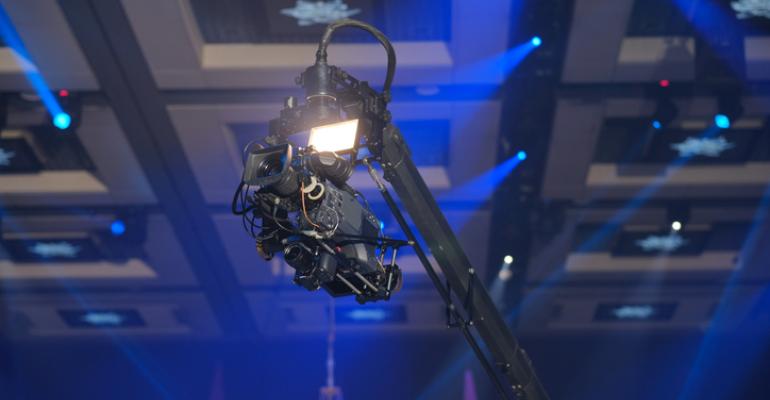Audiovisual services are technically challenging and sometimes a bit mysterious, so it’s nice to lean on your partners for support. But that doesn’t mean you’re off the hook. Understanding the basics of event sound, video, and lighting technology will help you know what’s available and how those options align with your goals when you meet with AV providers.
A foundation in audiovisual elements and how they affect an event’s success will make any meeting planner more effective. To get started, event AV production experts Will Curran, chief event Einstein at Endless Events, and Emmy Lumasag, people-experience specialist (I love that title!) at ElevateBio, provide some insight into critical AV concepts to understand and questions to consider.
Displays vs. Projectors
Room lighting, the size of the audience, and budget will all influence your choice to use projection, flat-panel displays, or LED screens. Projection is a relatively economical way to produce a large image but it requires a darkened room, so the ability to control the light in a space is key. If you have a bright room, consider displays instead. LED screens are on the expensive end, while flat-panel TVs are less expensive but smaller.
Rear-Screen vs. Front-Screen Projection
Rear projection means the projector sits behind the screen on the ground. It doesn’t require rigging, which is easier on the budget, but you need to plan for the required space. Rear projection creates “dead space” behind the screen that cannot be used for seating. Front projectors sit between the screen and the audience. They also take up some floor space, but the bigger issue is when people walk in front of the projector and cause a shadow on the screen. That issue is solved by rigging the projector to the ceiling, but that adds to the cost. Front projection usually produces a better image, but the difference may not be noticeable to the typical attendee.
Image Resolution
Video image resolution is expressed in pixels. At a minimum, look for “full HD,” which is also referred to as 1080p, and means there are 1,920 pixels displayed across the screen horizontally and 1,080 pixels down. For even better resolution, there is 4K. While it does have four times more pixels than 1080p, 4K is quite expensive to manage and display. If you need to show a lot of detail on a large scale, 4K might be warranted, but if not, 1080p is going to be fine.
Aspect Ratio
The ratio of the width to the height of a video, known as the “aspect ratio,” can vary. HD video is 16:9 while standard definition, or SD, is 4:3. If the aspect ratio of the video content doesn’t match the screen, the presentation will look bad. Make sure your presenters are using the correct aspect ratio.
Cameras
Camera also have different resolutions. At a minimum, ask for HD, 1080p cameras. Here again, 4K might be tempting as a sharper option, but if you’re not distributing or displaying in 4K, there’s no need for the extra expense. If budgets are tight, or the goal is to capture B-roll or smaller breakout sessions for online sharing after the event, a “pro-sumer” camera or SLR model can do the job. However, broadcast-grade cameras are most common for large-scale general sessions with a full stage setup.
Video Playback
It’s best to avoid playing embedded videos within a presentation. Even if it works correctly every time on the presenter’s laptop, a number of potential pitfalls are possible when connecting to an event's AV system. Everything from the laptop connection to the presentation management system and display hardware could cause a video file to lock up, ruining the pace and energy of a session. When possible, transfer the individual video files to the AV team or provide links to any online videos before the presentation, so they can play them back in the most seamless way.
Wireless Video
Wireless video is becoming more common as technology improves. But keep in mind that there can be interference issues, so always have a back-up option. Be prepared for the moment when a large audience enters a room and the number of wireless devices escalates, taking up WiFi signal bandwidth and potentially causing delays with your wireless video signal.
Digital Signage
With sustainability top of mind, groups can reduce waste by moving from printed to digital signage for wayfinding, room signage, and displaying the schedule. As a bonus, these displays are easy to update with last-minute changes. Many digital-signage software solutions can be integrated directly with event management systems, so corrections and updates happen automatically.
Lighting
Using interesting lighting is one of the most cost-effective ways to make your event look more professional and polished. The house lights at a venue are typically used during business sessions and lunch, but they won’t add much excitement during presentations and performances. Energy-efficient LED lighting can add a lot of visual ambiance and is available in a variety of colors. This is an easy and affordable option to elevate the look of your event rather than more props. More creative events might use beam lights (the laser-like lights often used at concerts) or spot fixtures. Gobos, which feature colors, logos, and images, are a fun way to create excitement around a brand or set the tone of your event.
Microphones
When deciding on microphones, think about the context. If the speaker needs to move around, select wireless over wired options. For the main speaker or presenter, lavalier microphones are typically best because once it’s in place on the lapel or collar, the speaker doesn’t need to think about it during the presentation.
 Remember to have an microphone and amplification solution for audience members if there’s any chance they will be asking questions n a large room. Hand-held mics are the most common solution, but think about how you will get the mics to the participants. You may want to assign a staff member or tech to this task. Here's a fun option: the Catch Box (in photo), which is a lightweight foam cover around a small microphone that can be tossed among people in the audience.
Remember to have an microphone and amplification solution for audience members if there’s any chance they will be asking questions n a large room. Hand-held mics are the most common solution, but think about how you will get the mics to the participants. You may want to assign a staff member or tech to this task. Here's a fun option: the Catch Box (in photo), which is a lightweight foam cover around a small microphone that can be tossed among people in the audience.
And finally, anything you want on your conference recording must be picked up on a microphone—even if the mic isn’t needed for sound reinforcement at the event.
Loudspeakers
Most house sound systems are designed to amplify the spoken word and are not ideal for playing music or other high-fidelity audio. Portable sound systems might be required; in some cases, the best results are a combination of both.
Production Intercom
Production intercoms are the wired or wireless headsets used by event AV production teams to communicate about show cues. For an event production with a lot of music changes, video content, and lighting cues, a production intercom helps everything run smoothly.
Kirsten Nelson is a writer and content developer for the Audiovisual and Integrated Experience Association (AVIXA).





